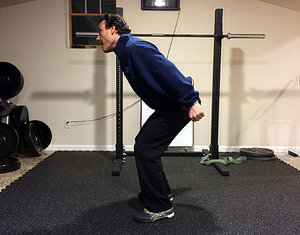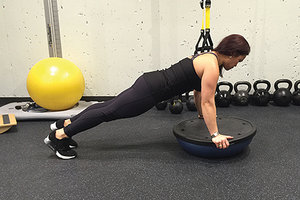For female athletes, the key to optimal athletic health lies in preventing ACL injuries. In medical terms, the anterior cruciate ligament (ACL) is the primary restraint to the anterior displacement of the tibia on the femur at all angles of the knee flexor.
What Causes an ACL Injury?
An ACL injury is usually caused by sudden, abrupt change in force to the knee. This can occur during an unexpected cutting move made during a sporting activity, or while landing following a jump in an athletic activity. Most ACL injuries occur in a non-contact setting and do not involve a collision with another player.1
What Does an ACL Injury Mean to an Athlete?
When an athlete injures the ACL, it may mean losing an entire season of play. If the injury is severe enough, it could also lead to surgery, resulting in long-term rehabilitation, a possible loss of scholarship, and emotional and mental strain. ACL injuries also could pose a lifelong potential for arthritis in the injured joint.2
Why Do They Occur More Frequently in Female Athletes?
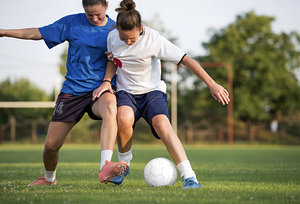 ACL injuries typically occur at a four- to six-times higher rate in females because they are more quadriceps dominant. Another factor may be decreased neuromuscular performance and increased ligamentous laxity during menstrual cycles from the fluctuation of female hormones.3-4 A study in The New England Journal of Medicine found differences in leg ailment of males vs. females, noting females have an increased rate of knock-knee (valgus deformity5). The intercondylar notch width is smaller in females, creating less space for the movement of the ACL and resulting in increased risk of injury. Women also typically have a wider pelvis, resulting in thigh bones angling downward more sharply (Q-angle).6 This leads to increased valgus stress and potential injury.
ACL injuries typically occur at a four- to six-times higher rate in females because they are more quadriceps dominant. Another factor may be decreased neuromuscular performance and increased ligamentous laxity during menstrual cycles from the fluctuation of female hormones.3-4 A study in The New England Journal of Medicine found differences in leg ailment of males vs. females, noting females have an increased rate of knock-knee (valgus deformity5). The intercondylar notch width is smaller in females, creating less space for the movement of the ACL and resulting in increased risk of injury. Women also typically have a wider pelvis, resulting in thigh bones angling downward more sharply (Q-angle).6 This leads to increased valgus stress and potential injury.
ACL Injuries and Hormones
Fibroblasts lead to collagen synthesis, which enables ligaments and tendons to heal. Estrogen (especially estrodial) inhibits fibroblastic proliferation. Collagen synthesis is significantly reduced with increased local estrodial concentration. Many high-school and college female athletes take birth-control pills, which are all estrogen-based and contribute to the potential for injury.
The National High School Sports-Related Injury Surveillance Study, currently in its fifth year of online data collection, has found that one ACL tear occurs every 15,000 times an athlete practices or competes. On average, athletes are eight times more likely to suffer ACL injuries in competition than practice. Data was collected from a national sample of nine girls’ high-school sports, including soccer, basketball, lacrosse, track, volleyball and softball.2
Most Common Sports for ACL Injury in Practice / Competition
- Injuries occur in girls’ soccer 1 out of 6,500 times an athlete practices or competes.7
- In girls’ basketball, injuries occur 1 of every 11, 000 times an athlete practices or competes.7
ACL Injury Rate Per Sport
A study in the American Journal of Sports Medicine (2009)8 concluded the following with regard to ACL injury prevalence by sport:
- An ACL sports injury prevention training program improved strength and flexibility in competitive female basketball players who were tested.
- The training program also improved biomechanical movement patterns associated with ACL injury as compared with pre- and post-training parameters in the control group.
Of clinical relevance is the conclusion that the prevention program lowered the athletes’ risk of injury.
A later study in the American Journal of Sports Medicine (2013)9 concluded that neuromuscular and educational interventions appear to reduce the incidence rate of ACL injuries by approximately 50 percent.
How to Prevent ACL Injuries
The key elements of a clinical program to prevent ACL injury include the following (see examples of each element below):
- Nutrition – supplements and proper diet
- Dynamic warm-up
- Stretching
- Strengthening
- Plyometrics
- Agility drills
- Cooldown
1. Dynamic Warm-Up
- Jog line to line (cone to cone)
- Shuttle run
- Backward running
2. Proper Stretching (Click here to learn how to stretch properly.)
- Calf stretch
- Quad stretch
- Figure-four hamstring stretch
- Inner thigh stretch
- Hip flexor stretch
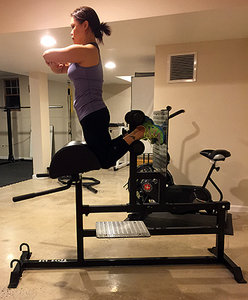 Glute-Ham Raise (start positions) 3. Strengthening (See descriptions / images of how to perform these exercises below.)
Glute-Ham Raise (start positions) 3. Strengthening (See descriptions / images of how to perform these exercises below.)
- Glute-ham raise
- Squat
- Leg curl
- Jump squat
- Single-leg, stiff-legged deadlift
- Bosu plank
- Walking lunges
- Assisted Russian hamstring curl
Glute-Ham Raise
- Raise or extend hips until torso is perpendicular with legs
- Raise body by flexing knees
- Lower body until horizontal by straightening knees
- Repeat
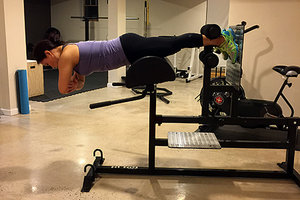 Glute-Ham Raise (finish positions) Squat
Glute-Ham Raise (finish positions) Squat
- Head straight, arms overhead
- Feet pointing straight or slightly toed-out
- Feet slightly wider than shoulder-width apart
- Knees in line with toes
- Squat back, not down
- Seated vertical, back flat, chest out
- Place lower calves over pad with legs out in front
- Brace upper body, use handles to assist
- Without moving back or hips, pull the pad down and back as far as you can
- Slowly return to starting position
- Start the same as the squat, descend slightly above parallel
- Propel body upward to max height
- Land in similar position, making certain to be soft on the knees
- Note: Do not adduct knees (bring knees together) upon landing
Single-Leg, Stiff-Legged Deadlift
- Stand on one leg, holding weight in both hands
- Keep back flat, lean forward at hips and lift free leg to the rear, in line with the torso
- Touch weight to the ground
- Return to starting position
- Keep back flat and form straight line from head to heels
- Tilt pelvis and contract abs
- Hold for 20-60 seconds
Assisted Russian Hamstring Curl
- Start on knees with arms up and partner holding your feet
- Keeping body straight, slowly lower yourself toward the ground in front until you can no longer hold yourself up
- Push back up with your hands to the upright position
- Repeat 20 times
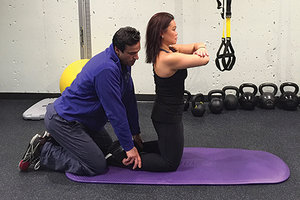 Assisted Russian Hamstring Curl (start position) Things to look for: Brace stomach while moving forward and back. Make sure not to arch back when returning to starting position.
Assisted Russian Hamstring Curl (start position) Things to look for: Brace stomach while moving forward and back. Make sure not to arch back when returning to starting position.
4. Plyometrics
- Lateral hops over cone
- Forward / backward hops over cone
- Vertical plyo jumps
5. Agility Drills
- Shuttle run with forward / backward running
- Diagonal run
- Bounding run
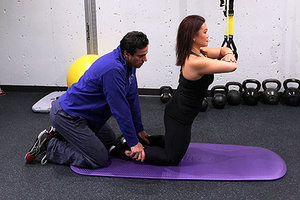 Assisted Russian Hamstring Curl (finish position) 6. Cooldown
Assisted Russian Hamstring Curl (finish position) 6. Cooldown
- Bridging with alternating hip extension
- Crunches
- Single / double knee to chest
- Piriformis stretches
The athlete’s fitness and desired level of performance will influence which of the above exercises are performed. Talk to your doctor before initiating any of these exercises to ensure proper / safe performance, particularly if you are have suffered an ACL injury of any type.
References
- Giugliano DN, Solomon JL. ACL tears in female athletes. Phys Med Rehabil Clin N Am, August 2007;18(3):417-38, viii. See also: Pasanen K, et al. Neuromuscular training and the risk of leg injuries in female floorball players: cluster randomised controlled study. BMJ, 2008;337:a295; published online ahead of print.
- Weekly blog post by Dr. D. Comstock, available on www.training-conditioning.com
- Spindler KP, et al. Clinical practice. Anterior cruciate ligament tear. NEJM, Nov. 13, 2008;359(20):2135-2142.
- Liu S. Estrogen affects the cellular metabolism of the anterior cruciate ligament. A potential explanation for female athletic injury. Am J Sports Med, 1997;25:704-709.
- Chaudhari AMW, et al. Anterior cruciate ligament-injured subjects have smaller anterior cruciate ligaments than matched controls: a magnetic resonance imaging study. Amer J Sports Med, 2009;37(7):1282-1287.
- Beynnon BD, et al. The effects of level of competition, sport, and sex on the incidence of first-time noncontact anterior cruciate ligament injury. Amer J Sports Med, August 2014;42:1806-1812.
- Statistics courtesy of the American Academy of Orthopaedic Surgeons.
- Lim B-O, et al. Effects of sports injury prevention training on the biomechanical risk factors of anterior cruciate ligament injury in high school female basketball players. Amer J Sports Med, March 2011;37(9):1728-1734.
- Gagnier JJ, et al. Interventions designed to prevent anterior cruciate ligament injuries in adolescents and adults: a systematic review and meta-analysis. Amer J Sports Med, 2013;41(8):1952-62.
Robert Silverman, DC, MS, CCN, CSCS,
